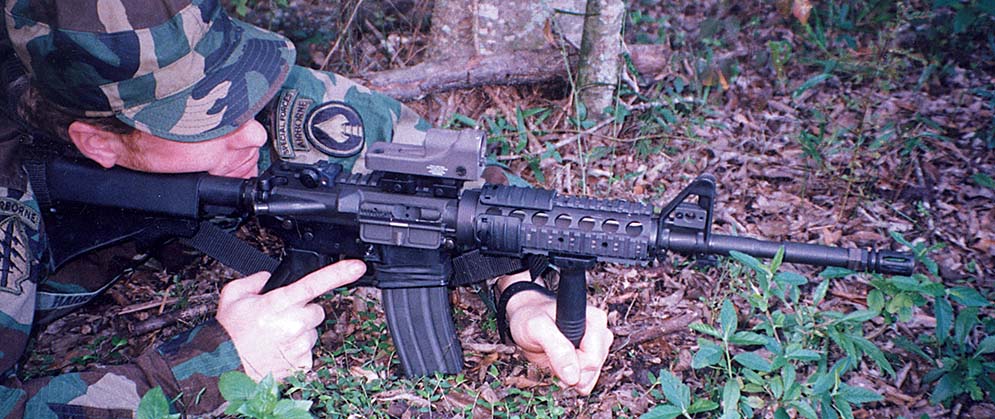By Charles Q. Cutshaw
Colt’s M4 and M4A1 carbines will soon be the standard arm of the US airborne and special operations forces, where they will replace the M16A2. The venerable Heckler & Koch MP5 submachine gun is also slated to be replaced in special operations forces by the subject of this article, the M4A1 Close Quarters battle (CQB) Weapon. The M4 is essentially an M16A2 with a 14.5 inch (368mm) barrel, while the M4A1 is the shortened version of the “flat top” M16A3. The primary differences between the M4 and M4A1 are the detachable carrying handle/rear sight assembly of the latter which is mounted on a MIL-STD-1913 “Picatinny Rail” and the fact that the M4A1 is capable of full automatic fire rather than having the M4’s three-round burst feature. The M4A1’s MIL-STD-1913 rail mounting system allows the flexibility of quickly mounting various optical sights and other accessories without losing weapon zero. Also, the devices are generally mounted in a position that does not demand that the shooter crane his neck to see through them, as is the case with fixed carry handle AR-15 type rifles and carbines.
While the M4A1 offers more flexibility than the standard M4, the weapon’s users desired even more flexibility – a truly modular weapons system capable of being configured for optimum effectiveness in any tactical situation. The US Special Operations Command (USSOCOM) synthesized the inputs and requested Crane Division, Naval Surface Weapons Center, to develop the system that eventually became the Special Operations Peculiar Modification to the M4 Carbine Accessory Kit. This piece of bureaucratic jargon is abbreviated SOPMOD M4, but it is probable that many who use the term are unaware exactly what comprises the kit, to whom it is issued and how it is employed. Essentially, joining the SOPMOD M4 Accessory Kit to the M4A1 Carbine results in the M4A1 Close Quarter Battle Weapon. We should note at this point that the Army has experimented with a carbine designated M4E2 that is essentially a burst fire M4A1 with the rail interface system described below.
The purpose of the SOPMOD M4 kit is to provide the US special operations forces with the ability to adapt their weapons to meet virtually any mission profile. This is necessary because SPECOPS units have no heavy weapons and thus must optimize the operational effectiveness of the weapons that they have. The SOPMOD M4 kit allows the user to “tailor” his weapon to the assigned mission. The kit is intended to optimize the effectiveness of the M4A1 from CQB/CRE range of less than 50 meters out to the 600-meter maximum effective range of the weapon. While the components of the SOPMOD M4 kit are current as of the time of this writing (July 1999), it is probable that they will change over time, as the kit is intended to evolve to take advantage of technology developments that enhance the effectiveness of the M4A1. (Some are currently under development and will be reported upon in SAR in the near future.) Unlike many other military requirements, development of new items for the M4A1 does not require a change to the requirements documentation. This enables USSOCOM and Crane to act rapidly to bring new items into the inventory. It is significant that virtually all components of the SOPMOD M4 kit are nondevelopmental items/commercial off the shelf (NDI/COTS), are available in the open market and can be mounted on any AR-15 – type carbine. As we explore the components, the reader can determine which of the SOPMOD M4 Kit components, he or she might like to add to their CAR-15 or equivalent. Most of these components will also fit an M16A4 configured AR-15-type rifle, as well. (The M16A4 configuration simply is an M16A3 flattop rifle length with the Knight’s Armament Systems Rail Adapter System (RAS), M5, full-length handguard.)
SOPMOD M4 Kits are issued on the basis of one kit per four carbines and consist of four of the following components: Rail Interface System (RIS), optical scopes, forward vertical hand grips and combat slings. Other items such as the reflex sight, suppressor and Quick Attach M203 are intended to be fitted to one or two carbines out of every four. While the basic “one kit per four carbines” is a general rule of thumb, if more of some items are required, shortfalls are made up from kits which are not required by other teams. Present issue is three kits per Army Special Operations Forces “A” Detachment (SFOD-A), two kits per “B” Detachment (SFOD-B), three kits per Air Force STT and four kits per Navy SEAL platoon. Army Rangers and other special mission units are issued selected components rather than complete kits.
As previously mentioned, the requirements documentation that resulted in the current SOPMOD M4 Kit is written to accommodate changes and upgrades, generally without rewriting. As technology, threats, missions and requirements change, the kit will likewise evolve to keep pace with them. Capabilities that are within those originally identified in the original requirements document do not require rewriting. That is, if a new or improved item is developed that is a significant improvement over an existing component of the SOPMOD M4 Kit, no rewrite of the original requirement is necessary, nor is any change required. If, on the other hand, the capability is a new one beyond the scope of the original documentation, the capability must be validated by USSOCOM and the requirement modified. Once the requirement is validated, the program office at Crane will conduct a competitive evaluation of candidates for selection. Now that we understand the M4A1 Carbine and the overall concept of the SOPMOD M4 Kit, we can proceed to the heart of the matter – the components that make up the kit. First, the basic SOPMOD Kit for four carbines consists of the following components in the quantities indicated in the chart on the top of page 26.
A detailed description of these components and their use is the subject of the remainder of this article. The first is the Day Optical Scope (DOS), Trijicon’s Model TAO1NSN 4x32mm Advanced Combat Optical Sight (ACOG). The DOS is intended to extend the carbine’s effective range to 600 meters. This version of the ACOG has the Bindon Aiming Concept reticle as standard. This system is similar to that used so many years ago by the Germans and to that espoused by Jeff Cooper for his scout rifle concept. The system uses a low power telescope and the “both eyes open” aiming method. As the rifle is brought to the shoulder, the image is unmagnified, permitting extremely rapid target acquisition. Once the rifle is in a shooting position and the shooter is close to proper sight picture with the optic, the target “snaps” into magnification, providing not only faster target acquisition, but also greater accuracy. The central crosshair reticle of the DOS is illuminated by tritium and gives off an amber glow for use in low light or darkness. The wavelength of the amber light is beyond those which night vision devices can sense and so does not affect their use. The DOS is waterproof for eight hours at 66 feet (20 meters) depth.
The 2.25x Miniature (Mini) Night Vision Sight (MNVS) is a small, lightweight and compact night vision sight that provides the capability to identify and hit targets from 20 to 300 meters. The sight is adjustable for windage and elevation and may be mounted on the carbine or hand held. The MNVS reticle is a simple red light emitting diode that subtends 2.5MOA at 100 yards. The sight weighs only 1.85lb (0.83kg, is 7.5in (190.5mm) in length and is powered by a single “AA” size alkaline battery that has an operational life of approximately 16 hours.
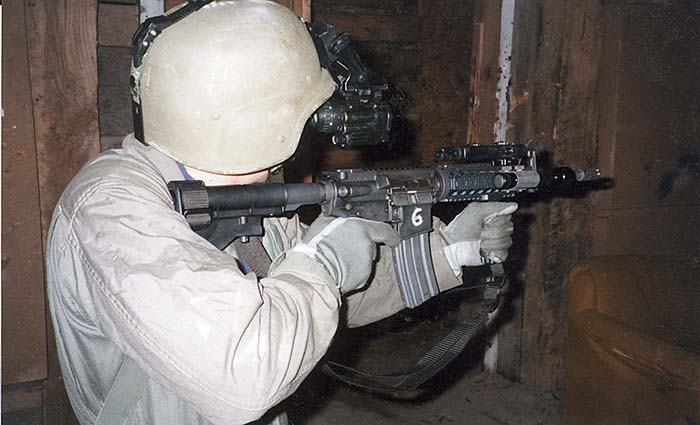
The SOPMOD M4 Kit also includes Trijicon’s ACOG Model RX01M4A1 Reflex Sight under the nomenclature Reflex Sight (RS) as a compliment to the 4×32 sight described above. The RS is a 1x day optic intended primarily for CQB/CRE ranges while still enhancing target acquisition and accuracy to a range of 300 meters. Like the 4×32 sight, the RS uses tritium to illuminate the reticle dot for low light and night operations. The dot is also illuminated by ambient light through a fiber optic cable that gathers light from beneath the lens. The collimator system eliminates parallax, so that if the dot appears on the target, it is properly aligned, regardless of the angle from which it is viewed. The design of the sight also provides for a virtually unobstructed view of the target. Like the DOS described above, it allows the shooter to employ the “both eyes open” aiming technique that enhances speed and accuracy at all ranges. The amber dot of the RS is identical to the DOS reticle frequency and thus is fully compatible with all night vision devices. The RS can be mounted either on the receiver rail or forward on the Rail Interface System, at the option of the user.
The question of why amber versus red reticles were used may be raised by some readers and the answer is because of night vision. Simply stated, amber is less destructive of night vision capability than red. The human eye is actually “night blind” at its exact center, where vision is sharpest. This is why, in the days before night vision devices, infantrymen (this writer included) were trained to observe at night without directly scanning the terrain and then to focus once something was detected. The rods that provide night vision are not affected by the amber glow, which is normally centered in the “night blind” area of the eye. In addition, of course, the amber color of the SOPMOD M4 sights do not affect night vision optics. The RS is issued with a polarizing filter for use under special conditions or with a flashlight, where it improves aiming dot contrast. The filter is not compatible with night vision devices. The RS is also issued with an accessory dust cover for use in extreme conditions.
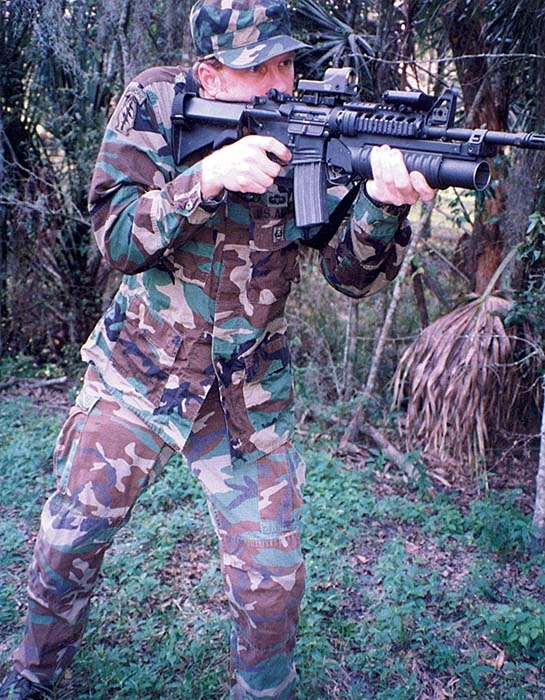
When the carrying handle/rear sight assembly is removed, the military recommends that the Backup Iron Sight (BIS) be installed at all times. This is an excellent policy because although modern optical sights are extremely reliable, one of Murphy’s Laws of Combat dictates that the most critical piece of gear will “go south” at the most inopportune time. Moreover, optical sights are complicated devices and thus susceptible to the “breakdown” law, while “iron” sights are about as simple as aiming devices can get. The sight used in the SOPMOD M4 Kit is simply clamped at the last notch of the receiver rail and folded down out of the way unless it is needed. The BIS is adjustable only for windage in .5 MOA increments. Elevation is adjusted using the front sight. The BIS is intended for use from CQB/CRE range to 300 meters. Once the BIS is zeroed, it can also be used to obtain an approximate zero for other accessory sights, although shooting with sights “zeroed” in such a manner is recommended only to a maximum of 100 meters.
The Knight’s Armament Company Rail Interface System (RIS) is a key component of the SOPMOD M4 Kit because it allows the mounting and operation of many of the kit components, including lasers, visible lights, the vertical handgrip and more. It is safe to say that without the RIS, the versatility and flexibility of the SOPMOD M4 Kit would be dramatically reduced; the RIS is truly the “core” of the SOPMOD M4 Kit. The RIS concept is a simple one. The system consists of two 6061 T6 aircraft aluminum hard anodized coated sections that replace the standard upper and lower M4A1 handguard sections. Upper and Lower RIS sections are not interchangeable. The lower section has a single MIL-STD-1913 rail and the upper has three such rails, 90 degrees apart, thereby providing four equally spaced rails when the RIS is installed. The top rail is slightly higher to align it with the top of the receiver. The RIS lower section has an aluminum heat shield on its inner surface. When there are no SOPMOD M4 Kit components mounted on the RIS, glass filled nylon rail cover panels are slid into place over the rails to provide a relatively even grip surface. The panels are available in varying lengths so that there is an even grip surface, even when accessories are installed.
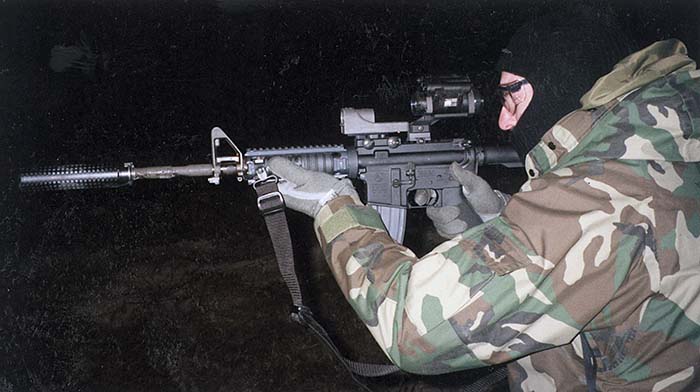
The Forward (vertical) Hand Grip, another Knight’s product, is installed at approximately the mid-point of the lower rail, depending on the user’s preference. The Forward Hand Grip provides better control of the carbine, especially when several accessories are mounted on the RIS. It also provides additional insulation when the carbine is being fired on full automatic.
The Insight Technologies Visible Light Illuminator is a very high intensity rail mounted light intended for search and clear operations in what the army currently euphemistically describes as “military operations other than war.” In plain English, this means “peacekeeping” or other “pizza delivery” missions which presently seem to occupy the preponderance of our military’s efforts. Tactical use of “white lights” must, of course, be balanced against revealing one’s position. The visible light is sufficiently bright, however, to briefly dazzle adversaries in CQB/CRE situations, thus providing a moment’s advantage to the user. An infrared (IR) filter may be placed over the light to allow IR illumination of targets out to 50 meters. The light is powered either by three DL 123 lithium batteries or by six 1.5 volt “AA” size batteries.
The Insight Technologies AN/PEQ-2 Infrared (IR) Target Pointer/ Illuminator/Aiming laser allows the carbine to be used with any one of several night vision optics, including the standard head mounted goggles, a head or weapon mounted pocketscope, or the issue Mini Night Vision Sight (MNVS), described elsewhere. It is intended for use inside buildings and elsewhere where vision using the NVG would be problematic due to lack of available light. A neutral density filter that prevents “blooming” is used with the laser at close ranges.
Insight Technologies’ AN/PEQ-5 Visible Laser is mounted on the rail interface system and is used for close range engagements. The intent is not to replace the optical sights, but to supplement them in interior lighted areas or in dark rooms in conjunction with the visible light illuminator, or at night in conjunction with night vision equipment.
The Knight’s Armament Company sound suppressor is designed for quick attachment/detachment and reduces the M4A1 noise signature at the muzzle by approximately 28db. The suppressor also significantly reduces the flash signature. Taken together, the sound and flash reductions not only confuse adversaries, but also enhances team communications and reduces the need for hearing protection.
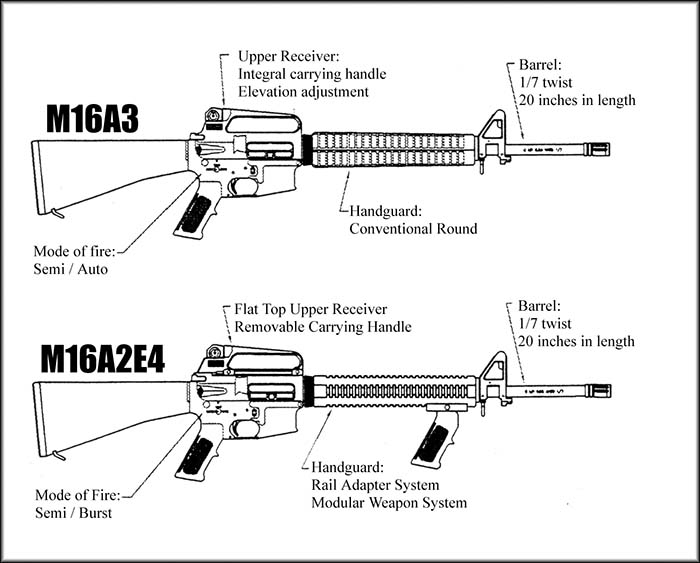
The M203 Mount and Leaf sight, although capable of being quickly and easily attached or removed, are rarely dismounted once they are installed on a particular carbine. Other than its shorter barrel, the M203 is identical to the version used with M16 rifles.
A special sling that provides secure cross body or patrol carry is used with the M4A1 CQB Weapon. Whether in column, “stack,” or moving in close quarters, the sling helps the user maintain control of the weapon’s muzzle. The sling has a removable mount that attaches at the front sight/gas block or to the rail interface system. The sling does not interfere with any components that may be mounted on the rail interface system.
Finally, the enhanced collapsible stock improves the M4A1 CQB Weapon’s ergonomics by enhancing the cheek weld for improved pointing at close range and enhanced aiming at any range. The stock also has compartments to accommodate spare batteries for kit accessories.
One of the keys to the success of the SOPMOD M4 Kit is the fact that the vast majority of its components are commercially available. As mentioned above, most can be purchased commercially by any owner of an M16/M4 type carbine who wishes to create a truly modular firearms system. Thus, any agency wishing to equip itself with M4A1 CQB Weapons can do so by modifying their existing M4/M4A1 – type carbines, regardless of manufacturer. Contact information for manufacturers of selected SOPMOD M4 Kit Components is included below. We do not include carbine contact information in this list, as ArmaLite, Bushmaster, Colt and Knight’s all produce carbines suitable for modification into SOPMOD configuration.
ACOG Reflex Sight
and ACOG 4x Scope
Trijicon, Inc.
49385 Shafer Ave.;P.O. Box 930059
Wixom, MI 48393
Tel:248-960-7700; Fax: 248-960-7725
On-line: www.trijicon-inc.com
Visible laser, AN/PEQ-5;
IR Laser Pointer/Illuminator,
AN/PEQ-2; Visible Light
Insight Technologies, Inc.
10 Tinker Ave.
Londonderry, NH 03053
Tel: 603-626-4800; Fax: 603-626-4888
Rail Interface System; QD Suppressor; Forward hand Grip; Backup Iron Sight; M203 Quick Detach Bracket
Knight’s Armament Company
7750 9th Street, SW
Vero Beach, FL 32968
Tel: 561-562-5697; Fax: 561-596-2955
The author wishes to express his sincere appreciation to LTC Mike Harris (Ret) whose assistance made this article possible.
| This article first appeared in Small Arms Review V3N2 (November 1999) |



